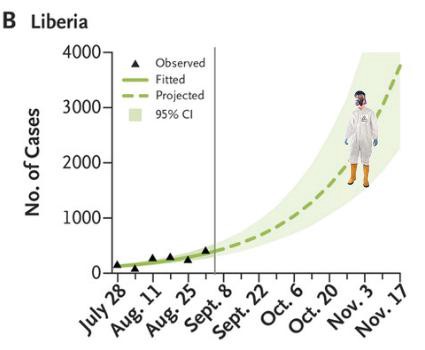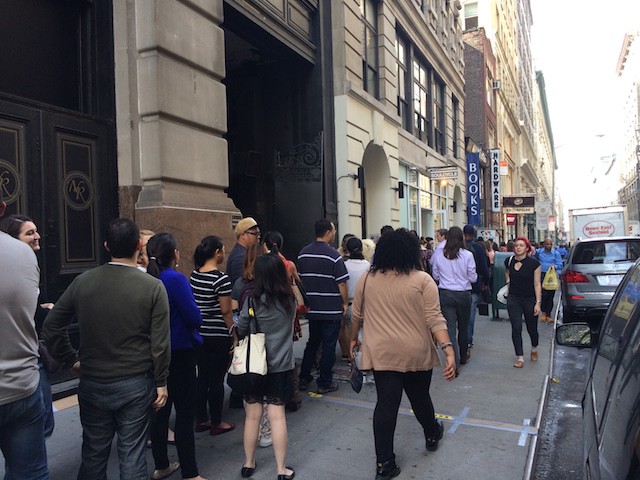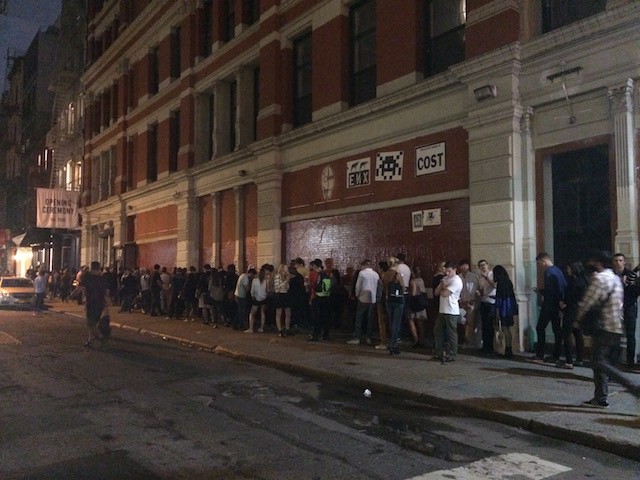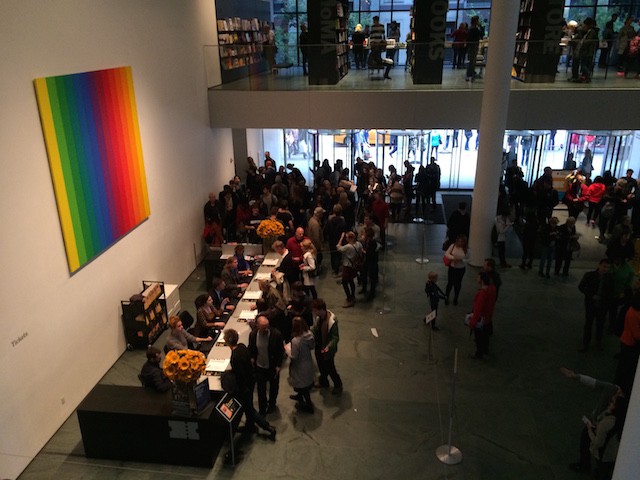Shabazz Palaces, "Motion Sickness"
A narrative video for one of the more accessible tracks on the excellent Lese Majesty, which I’ve been coming back to again and again over the last couple months (see previously: #CAKE).
Modern Experience Rendered Accurately
Who do you identify with? Is it one of the many Waldos? All of the Waldos? The guy relaxing briefly at the axis? The unstoppable spinning prism itself? One of the few people who, at the very beginning, runs and then jogs and then walks out of frame?
The object label for this installation (via Chuck Anderson) reads:
Crowd dynamics test using Miarmy for Maya.
Shows the new servo force feature which allows struggling animation once the agent has become dynamic
Rendered with Arnold
The New York City Tourism Association Thanks You for Visiting the Apple Store
by Matthew J.X. Malady
People drop things on the Internet and run all the time. So we have to ask. In this edition, Slate Assistant Editor Miriam Krule tells us more about intergenerational information transfer at the Apple store in Grand Central Terminal.
Working from Apple store in Grand Central where a teen is teaching old ladies how to use a comp. Tourist just walked by and took photos.
— Miriam Krule (@miriamkrule) October 8, 2014
Miriam! So what happened here?
I was heading to Connecticut to celebrate the festival of huts out in the wilderness. My ride had fallen through, so I was taking the train, but the only one that worked for various boring logistical reasons was essentially midday. My parents live in New Jersey, so even though I grew up in New York, I’ve spent very little time in Grand Central Station and didn’t exactly think things through, figuring I could work from there in the morning. I found a nice quiet corner, only to realize that there’s no magical train station Wi-Fi (coincidentally this was as news of “Wi-Fi is a human right” was blowing up). Just as I was about to cave and pay for it (aka, look for a Starbucks), I saw an Apple Wi-Fi option and basically searched for a strong connection and ended up in the Apple Store, which I had no idea existed. (For future reference, it’s on this majestic balcony overlooking the main floor. Also, it’s impossible to miss.)
Grand Central is a funny place, but the Apple Store in Grand Central is its own level of insanity. A) There’s an Apple Store less than a mile away B) Who makes expensive electronic purchase in a train station? Anyway, I found a quiet area and got to work. One of the Apple Genius people was chatting with her friend — who, incidentally, was nursing her newborn. (Everyone kept coming by and oohing and ahhing.) They were gossiping about a third friend, but the woman with the baby was holding an iPhone so it looked like she was asking questions. They were there for about an hour, so I figured if no one was bothering them, no one would bother me with my Apple product either.
Turned out though, it was quiet for a reason — it was the room that they have classes in. But C) Who goes to an Apple class in Grand Central Station? I just imagine these people being like, “Oh, I’ll take the 3:34 from New Haven so I can make that how to use the cloud class.” Anyway, the answer is old ladies. There were six of them sitting on those super uncomfortable high stools (I was getting cranky by this point — I’d bought lunch but thought it might be a bit more problematic if I whipped it out and started eating) learning how to send emails. Granted, that may not have been what the class was about, but that’s what it became. The teenage teacher did not bat an eye though. The women wanted to learn about email, so there was essentially an hour-long class about email. There was absolutely zero nuance to it — I zoned in and out, but just remember listening in and thinking “they’re STILL talking about email?” At one point, one of the women asked why the mailbox icon was shaped like an envelope. I wanted to jump in and opine about skeuomorphs, but thought better of it.
So this was all happening, which was amusing enough. Then, a GROUP OF TOURISTS WALKED BY. In a store in a train station. And took photos. Of the old ladies. It was so strange. They did not turn the flash off.
Did the teen seem to be getting through to the pupils?
To be honest, I was a bit preoccupied with my own stuff, but one of the women did come back and ask why what he had taught wasn’t working for her. He explained that she was using an iPhone, not a computer.
Lesson learned (if any)?
Train stations aren’t just for trains anymore. They’re for computer classes.
Just one more thing.
Trains are an awesome way to travel — especially in the beginning of fall. (I feel like saying that is somehow un-American.)
Join the Tell Us More Street Team today! Have you spotted a tweet or some other web thing that you think would make for a perfect Tell Us More column? Get in touch through the Tell Us More tip line.
Matthew J.X. Malady is a writer and editor who was in New York but is now in Berkeley.
Court Meddles
Court Meddles
“A pregnant unwed mother can’t use Facebook alone to notify the father about the baby before putting the child up for adoption, Oklahoma’s highest civil court has ruled.”
Your Ebola Halloween Costume: A User's Guide

So you’re doing “Ebola” for your halloween costume this year. You’ve found a topical novelty outfit online, or maybe you’ve just purchased some cheap and readily available medical clothing, knowing that your peers will have no problem guessing what it’s supposed to represent.
But “Ebola” is going to be a very popular costume this year. You’re not the only person who heard about this epidemic on the news! If you want to stand out — if you want to be the star of the party, by evoking Ebola hemorrhagic fever — you need to study up. Here are some helpful facts that you can recite to your friends in order to give your Ebola costume that extra dimension of authenticity.
• Ebola kills quickly and painfully. There is no known cure, or vaccine, and the best available treatment in most cases, according to the CDC, is “providing intravenous fluids (IV) and balancing electrolytes (body salts).”
• Ebola is characterized, early on, by fever, weakness, headache and diarrhea. This is followed by hemorrhaging and near-total loss of responsiveness.
• Direct contact with infected patients is the primary mode of transmission for Ebola. Therefore, this disease is most dangerous to the people who choose to provide treatment to the afflicted. Many, many medical professionals have died trying to give care and slow the spread of this terrifying disease.
• Ebola has spread most profoundly in Guinea, Liberia, and Sierra Leone, where a paucity of medical and emergency infrastructure has allowed the disease to spiral out of control. (Don’t worry: These places are all at least 4,000 miles away from the nearest American Halloween parties.) Facilities that do exist have been largely overwhelmed, creating hellish scenes of suffering.
• Many of the people fighting this disease do not have access to necessary PPE (Personal Protective Equipment) — equipment that you will be wearing, either in real or replicate form, to a sports bar or fraternity party on October 31st. (Careful: The CDC says that proper PPE “significantly reduces the body’s normal way of getting rid of heat by sweating,” increasing the risk of dehydration and heat-related illnesses.)
• Speaking of October 31st: That’s a date by which the WHO estimates that well over 20,000 people will have been infected with the disease:
As of September 14, the doubling time of the epidemic was 15.7 days in Guinea, 23.6 days in Liberia, and 30.2 days in Sierra Leone. We estimate that, at the current rate of increase, assuming no changes in control efforts, the cumulative number of confirmed and probable cases by November 2 (the end of week 44 of the epidemic) will be 5740 in Guinea, 9890 in Liberia, and 5000 in Sierra Leone, exceeding 20,000 cases in total. The true case load, including suspected cases and undetected cases, will be higher still.
• To provide more visual context to other partygoers, you can show them this image. That’s you in the suit. You have been superimposed over the WHO’s projection for Ebola infections in Liberia at Halloween-time, approximately.

• Ebola has killed 4493 people as of writing. But by the time it’s time to dress up for Halloween, that number will be out of date. Don’t give the other partygoers the wrong info: Before suiting up, check again. (Current estimates suggest that the number of deaths will have doubled.)
• Use anecdotes to really drive home your costume concept. Here, a photojournalist describes what the epidemic looks like on the ground:
In one of the most emotional encounters I faced in Liberia, I photographed a family that accompanied a sick woman who seemed near death as they sought treatment. She was bleeding from the mouth and her breathing was shallow; she was not ambulatory. As the husband, a sister, a brother and a friend descended from the van, each wore large plastic bags around their hands, feet and bodies, trying to protect themselves from infection with makeshift coverings. They knew it was the only way to get their very ill relative to the Doctors Without Borders Ebola treatment unit. Waiting outside the gates was a given, but to the anxious family, I am sure one hour seemed far too long as the patient worsened.
An alternative plan: For supreme costume authenticity, quarantine yourself in your home for 24 hours starting on Halloween morning.
Pity the Poor Bodega Cigarette Man
Upon closer inspection of the shelves, he noticed that the rear wall stopped short, a couple of inches from the other side, suggesting a gap in between. He peered lower. There was a pinpoint hole in the rear wall. Below it, a toothpick lay on the shelf. Deputy Davis, 43, stuck the toothpick in the hole.
The toothpick pressed a hidden button that released a large magnet that kept a secret compartment locked. Deputy Davis lifted the front of the row of shelves like you would the trunk of a small car, and inside were rows and rows, all different brands, of contraband. Not narcotics or pills, but unopened packs of cigarettes, perfectly legal in the state in which they were bought, but not here. Hence the secret compartment.
You might be wondering: How much are cigarettes from state to state, such that bodegas — forty-eight percent of those inspected by police — stock illegal cigarettes as a matter of course?
What a marvelous excuse to highlight the Awl’s annual state-by-state cigarette price index. As the Awl’s summer intern discovered a couple months ago, Virginia, where most of the contraband cigarettes seem to come from, sits squarely in the nexus of close and cheap, at $5.25 a pack, making it tied with Missouri for the cheapest cigarettes in the nation.
Light one up for poor Ahmed.
New York City, October 16, 2014

★★★ A soaking rain, lingering from overnight, went off and on before shutting fully off at midday. From the west, the sky began to go blue. The once-fetid air had cooled. The clouds kept dissolving till there was blue shining in the puddles. The sidewalk tables went into service for lunch. Finally the clouds were nothing but gorgeous piles of light and shadow, pure harmless scenery.
This Week in Lines: Some Things in Life Are Kinda Free
by Jake Gallagher

1:34 PM Wednesday, October 15th — Free donuts for the Dough opening
Location: 14 West 19th Street
Length: A hundred and ninety-two people with inner Homer Simpsons
Weather: 77 and partly cloudy
Crowd: Local office-workers, for whom a free donut is probably the highlight of their week
Mood: Excited enough to make me question whether or not these people need anymore sugar in their systems
Wait time: Fifty minutes
Lingering question: How long can one function at work after consuming a Dulce de Leche donut?

6:47 PM Thursday, October 16 — Zhu Tickets
Location: Opening Ceremony, 35 Howard Street
Length: Eighty-seven people
Weather: 67 and partly cloudy
Crowd: An inexplicable blend of normcore twenty-somethings and aging finance bros
Mood: Smug
Wait time: Over an hour
Lingering question: What does it mean that I don’t know who Zhu is?

2:08 PM Saturday, October 11 — Ticket Line
Location: The Museum of Modern Art
Length: Around the entire lobby and out onto 54th Street
Weather: 59 and cloudy
Crowd: A mix of Matisse fans trying to get an early glimpse at his new show and tourists who come to MoMA because that’s just what you do
Mood: Abstract
Wait time: Thirty-five to forty minutes
Lingering question: How many selfies get taken at MoMA a day?
Jake Gallagher is a writer for A Continuous Lean and other places.
The Need to Make Believe
by Casey N. Cep
The last thing I made was my bed. Soon I will make some toast, and later today I will make plans for this weekend. We all make things, abstract and actual, every day. Some people just make do and others make deals, but we all make believe. That capacity for fiction serves us well, though sometimes too well.
One of my favorite songs from the fifties is about that beautiful but beguiling ability to pretend things are other than the way they are. Why accept the end of a relationship when you can pretend it never happened? I’ve listened to many covers of “Making Believe,” one of those songs that artists just can’t stop covering, but it’s the shaky sincerity in Kitty Wells’s voice that makes me love her version most. Her sadness is so, so sweet that it’s never enough to listen once; you want to hear the song over and over again, even though you know every time that it’s sad to make believe for so long — tragic to refuse to accept that someone has stopped loving you.
Kitty Wells was born Ellen Deaso, but used a stage name suggested by her husband. She was in her thirties before she got her first real break, recording a song called “It Wasn’t God Who Made Honky Tonk Angels,” a feisty rebuttal of Hank Thompson’s “The Wild Side of Life.” It might have been written by a man, but it stood up for women: Instead of accepting that fiancés and wives were to blame for failed engagements and marriages, Wells sang, “Every heart that’s ever been broken was because there always was a man to blame.”
The top song on the country charts for fifteen weeks in 1952, “It Wasn’t God Who Made Honky Tonk Angels” included the lyric: “It’s a shame that all the blame is on us women.” Three years later, Wells covered “Making Believe,” a song in which there’s no blame, really, just regret. The singer is “making believe that you still love me,” but “it’s leaving [her] alone and so blue.” What to do when the one you love leaves? The song is so plaintive that we postpone our usual advice: Move on we’d say or get over her. But, hearing “Making Believe,” all we do is listen, believing she’ll never move on, instead living the rest of her life “making believe that I never lost you.”
But there’s a kind of longing that not even daydreams can satisfy; a kind of loss that not even make-believe can lessen. It’s usually death that separates us so definitively, but “Making Believe” is about a separation that’s even worse because the possibility of reconciliation, however small, remains: The one you love hasn’t died, just found someone else. And no matter how many times I hear the song, even though I know it has no happy ending, I always hope that the fifth time’s the charm, and when Wells croons “making believe” five times, the person who loved her once will love her again.
The reunion never comes. The ending is never happy. There’s such so much now (“my happy hours I find are so few”) and so much always (“my plans for the future will never come true”) that we resign ourselves to the singer making believe forever, refusing to find someone new. Like an anti-wedding vow, she commits herself not to partnership but pining: “I’ll spend my lifetime loving you, making believe.”
I have lots of friends who thought they would never move on — who went weeks, months, and sometimes even years after a breakup convinced that they couldn’t. Eventually, they all did; the kind of lifelong pretending, unending “making believe” because “what else can I do” is a rare thing indeed. One of the reasons I love Kitty Wells’s “Making Believe” is that she doesn’t just make herself believe, she makes all of us believe, too, in a love so fierce that even when it fails, it’s never abandoned.
Country Time is an occasional column about country music.
Casey N. Cep is a writer from the Eastern Shore of Maryland.
Do Not Roast the Squash

Trends and memes may be on the side of fall and winter squash — I dare you to find a single vendor without some variety of pumpkin foodstuff between September and December — but I rue the transition from light, delicate, and fresh summer squash, like zucchini, to heavy, sugary, and starchy winter squash, like acorn, pumpkin, delicata, butternut, and, of course, pumpkin. The most common way to eat winter squash, the one I see at potlucks and on restaurant menus alike, is actually the worst: a simple PC&R; (peel, cube, and roast).
This is a very good way to cook almost any vegetable, but a bad way to cook winter squash. Summer squashes are typically eaten young, while the seeds and skins are still soft and edible — even raw — while winter squashes have been allowed to grow to a mature stage, so they are hardier; their flesh is dense and sweet and their skin tough and sometimes warty. This makes them very resistant to winter temperatures, but their texture makes people think they can be treated like potatoes or sweet potatoes, with a PC&R.; Nope.
I have tried every possible way to PC&R; winter squash: I have par-boiled; I have sous-vided; I have covered in aluminum foil; I have experimented with every possible temperature and timing and size and shape and amount of oil. My final conclusion is that there is no good way to PC&R; a butternut squash or pumpkin. The pleasure of a roasted starchy vegetable is in the crispy exterior and pillowy interior, but this does not happen to winter squash — the only thing it does well in the oven is turn to mush.
This is all not to say that there are no good ways to eat winter squashes. That very tendency to turn to mush can be embraced. The squash is mush. Let it be mush. This means transforming it into soups, sauces, and purees, where the winter squash’s mushiness and heaviness become creaminess and richness. Here’s how to cook them properly.
I’m not going to recommend specific winter squashes for these recipes but will instead treat them as one monolithic squash. The varieties of winter squashes have largely similar flavors, and since we’re going to be pureeing, we don’t really have to worry about texture.There will be minor flavor differences that will need adjusting; kabocha, one of my favorites, is extremely sweet, so will need less (or no) added sugar, but for the same recipe, a less-sweet acorn squash might need a hit of honey or brown sugar. But largely, you can substitute in pretty much any squash for these recipes. (The only winter squash that won’t follow these rules is the noble spaghetti squash, one of the weirdest native plants in all of the New World. I love spaghetti squash, but let’s set it aside for now; it is not like the others.)
My basic winter squash soup is thus: Cut the squash in half, then scoop out and discard its guts (not the flesh, but the goopy stuff that actually looks like guts). Scoop out the seeds too, but don’t throw them away (more on that later). Rub the cut side of the flesh with oil and sprinkle with salt and pepper, then place the squash, cut side down, on a baking tray and roast at 375 degrees, until soft. The amount of time depends on the size and type of squash; maybe thirty minutes, maybe an hour. I don’t know. If you want to send me a picture of your squash next to a ruler, I could send you back a guess of how long it will take. Or you can just poke it with a knife to see when it’s soft. It should slide in with very little resistance.
While the squash is roasting, take out your dutch oven or otherwise large heavy soup-friendly pot. Put a few tablespoons of oil in, then add half of a medium-sized onion, chopped, and a few cloves of garlic, also chopped. Sautee until onions are translucent, then add in some chopped up apple. How much apple will depend on the size of your squash, but about two apples for a medium-sized butternut squash, or a single large apple for a medium-sized acorn squash, usually does it for me. Lean towards a more tart than sweet apple, like a Jonagold, Jonathan, McIntosh, or even a classic Granny Smith. Cook until the apples are soft. By this point hopefully your squash is done. Take it out, let it cool, and then get rid of the peel somehow. You might be able to peel it back with your hands, but I usually can’t; just scooping it out with a spoon works fine. Toss all this mush into the pot, stir it around, then add the stock of your choice — chicken is best, vegetable is fine, beef is weird — until the mush is covered by about half an inch. Simmer this for about ten or fifteen minutes to let all the flavors get friendly with each other, then blend it somehow.
On the subject of blending: the best tool for this job is an immersion blender, which is cheap on Amazon. (This one looks nice.) Stick the blender right into the pot and blitz it for longer than you think you need to. When you think it’s done, go back and do it some more. When done, it should be absurdly velvety and thick and delicious. Season to taste; it will need a lot of salt and possibly some sugar or honey (I like honey).
There are lots of possible additions to squash soup. My favorite is to add in some cumin, coriander, and cayenne (more cumin than coriander, but just a sprinkle of cayenne) along with the apples, then to finish, spoon some tahini in the middle of the bowl of soup and sprinkle some za’atar spice mix, some toasted pine nuts, and some pomegranate seeds (I know, they’re called arils, shut up) on top. You can also swap out the oil for bacon fat way back at the beginning of the recipe; cut about four strips of bacon into small pieces and put them in the pot first. Render out their fat, and when crispy, remove them and put them on a paper towel for the rest of cooking. Cook everything else the same way, then sprinkle the crispy bacon bits on top of the soup. One final way: throw in some chopped chiles (one Thai bird’s eye is what I do) and ginger (a knob about as big as your thumb) in the beginning, then throw in a good curry mix with the apples. Serve with a spoonful of coconut milk, some cilantro pesto, and the toasted seeds of the squash you’re cooking with.
You’ll notice that the intermediate-level recipes above all have toppings. This is vital; a squash soup has only one texture and its flavor, though complex, is uniform and doesn’t change from bite to bite. So you need some kind of variation, and toppings are a great way to do that (and they look very professional). Croutons are okay, but I find they get a bit soggy. I prefer stuff that doesn’t: nuts, crisped meats, or crunchy fruits or vegetables. Raw apple is weird and nice. Also nice are pine nuts, walnuts, or peanuts, depending on what flavor profile is in the soup. Bacon, pancetta, or speck works well when crisped up. But the best of all is the roasted seed of the squash that you made the soup from.
(Ah ha, yes. The most important thing about squash is that all squash seeds are edible. I would further suggest that they are not just edible but actually the best part of the whole dumb vegetable. Wash them thoroughly, then set on a clean dish towel overnight to dry. They take forever to dry; I’m not sure why. Mix with maybe a tablespoon of oil and some salt, spread on a sheet, and roast in either the regular oven or the toaster oven at 300 degrees until slightly browned, which should take around half an hour. Feel free to experiment with seasonings, but I usually like to keep them bare and add spices later, because who knows what kind of dish they’ll be used in later!)
The weirdest thing about this soup is that, well, it’s also a sauce. It’s thick and rich and very flavorful, and you don’t actually have to do anything to it to make it a sauce. One way I like to use it is as a sauce for a pasta bake. Boil some creatively shaped pasta — elbows are fine, as are pretty much anything that’s not a strand-shaped pasta. Take out a baking dish and lay down a layer of soup/sauce. Mix the pasta with soup/sauce, as well as some cheese (chevre is my favorite) and sausage, if you want, and throw it in the dish. Now take about three tablespoons of butter and melt it in a pan on the stovetop, then add a cup of breadcrumbs (or panko). Mix and toast for a couple minutes, then lay down on top of the pasta bake. Throw the whole thing in the oven at 400 degrees and bake until the crust top is browned — about thirty minutes. (You’ll notice this is basically a macaroni and cheese recipe. It is not a substitute for macaroni and cheese, and for the love of god it should not be treated as some kind of sneaky trick to get people to eat vegetables. It is a squash and pasta casserole, not some kind of also-ran to macaroni and cheese.)
One last suggestion: risotto. Butternut squash is common in risotto, but almost always it’s done by throwing chunks of squash into the risotto. Jesus. Gross. Why mess up the perfect texture of risotto with mush-chunks? Instead, just use the squash as a thickener and richener (that’s not a word, is it? It’s good though, I think) for the stock. Peel and cube your squash, of any variety, and toss it in a simmering pot of stock until the squash is soft. It should be much more stock than squash; imagine a matzoh ball soup, where the squash is the matzoh ball. Then blend with your trusty immersion blender, and make risotto as usual. This is a good recipe to follow for that; ignore the saffron and use your new squash stock instead of regular stock.
Winter squash, truth be told, is not my favorite ingredient; I tend to prefer brightness and crispness, and winter squash doesn’t really offer that. But that doesn’t excuse the way it’s usually treated: as a mushy version of a potato, one that falls apart before reaching the heights of roastiness. Turning it to a rich liquid — now, that takes advantage of the squash’s strengths.
Crop Chef is a column about the correct ways to prepare and consume plant matter, by Dan Nosowitz, a freelance human who enjoys hot salads and lives in Brooklyn, naturally.
Photo by Nora Kuby
